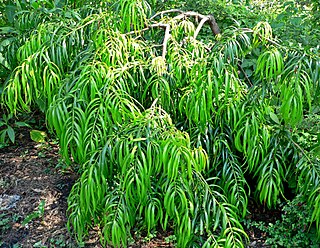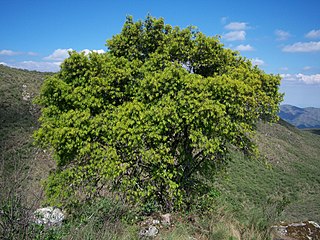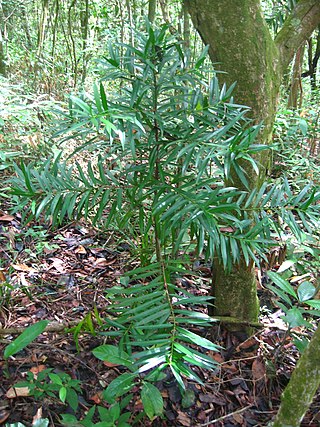
Podocarpus latifolius is a large evergreen tree up to 35 m high and 3 m trunk diameter, in the conifer family Podocarpaceae; it is the type species of the genus Podocarpus.

Podocarpus totara is a species of podocarp tree endemic to New Zealand. It grows throughout the North Island and northeastern South Island in lowland, montane and lower subalpine forest at elevations of up to 600 m.

Prumnopitys taxifolia, the mataī or black pine, is an endemic New Zealand coniferous tree that grows on the North Island and South Island. It also occurs on Stewart Island/Rakiura but is uncommon there.

Podocarpus is a genus of conifers, the most numerous and widely distributed of the podocarp family, the Podocarpaceae. The name comes from Greek πούς + καρπός. Podocarpus species are evergreen shrubs or trees, usually from 1 to 25 m tall, known to reach 40 m (130 ft) at times. The cones have two to five fused cone scales, which form a fleshy, berry-like, brightly coloured receptacle at maturity. The fleshy cones attract birds, which then eat the cones and disperse the seeds in their droppings. About 97 to 107 species are placed in the genus depending on the circumscription of the species.

Podocarpus drouynianus is a species of podocarp native to the relatively high rainfall southwestern corner of Western Australia, where it is known by the name emu berry, wild plum or native plum although it is not a true plum. The Noongar name for the plant is koolah.

Podocarpus nubigenus is a species of podocarp, endemic to the Valdivian temperate rain forests of southern Chile and adjacent southwestern Argentina. It is the southernmost podocarp in the world. It grows from 38°S to Ultima Esperanza (53°S), in wet and swampy soils. It can settle clear grounds, with a faster growth than the other Chilean Podocarpaceae.

Podocarpus angustifolius is a species of conifer in the family Podocarpaceae. It is endemic to Cuba.
Podocarpus borneensis is a species of conifer in the family Podocarpaceae. It native to the island of Borneo, which is divided between Indonesia and Malaysia.
Podocarpus capuronii is a species of conifer in the family Podocarpaceae. It is endemic to Madagascar.
Podocarpus confertus is a species of conifer in the family Podocarpaceae. It is endemic to Borneo.
Podocarpus coriaceus, commonly known as the yucca plum pine, is a species of conifer, an evergreen tree in the family Podocarpaceae. It is found in the Dominican Republic, Guadeloupe, Martinique, Montserrat, Puerto Rico, and Saint Kitts and Nevis.

Podocarpus laetus is a species of conifer in the family Podocarpaceae, commonly known as Hall's tōtara, mountain tōtara or thin-barked tōtara. Previously known as Podocarpus hallii and Podocarpus cunninghamii, in 2015 it was realised that the much earlier name P. laetus has priority. Its common name results from the species being named after J. W. Hall, a New Zealand pharmacist.

Podocarpus henkelii is a South African species of conifer in the family Podocarpaceae. It is grown ornamentally in gardens for its strikingly neat, attractive form and its elegant, drooping foliage.
Podocarpus laubenfelsii is a species of conifer in the family Podocarpaceae. It is native to Borneo.
Podocarpus ledermannii is a species of conifer in the family Podocarpaceae. It is found on New Guinea and the Bismarck Archipelago in Indonesia and Papua New Guinea.

Podocarpus matudae is a species of conifer in the family Podocarpaceae. It is found in Guatemala, El Salvador, Honduras and Mexico.

Podocarpus milanjianus is a species of conifer in the family Podocarpaceae. It is native to the highlands and mountains of tropical Africa.

Podocarpus neriifolius is a species of conifer in the family Podocarpaceae. It grows 10–15m tall, though very occasionally taller, in tropical and subtropical wet closed forests, between 650m and 1600m altitude. In Cambodia however it grows in a dwarf form some 2–4m tall, at Bokor, some 1000m elevation.

Podocarpus parlatorei is a species of tree in the family Podocarpaceae and native to Argentina and Bolivia, where it grows on steep hillsides on the eastern flanks of the Andes. It has been harvested commercially in the past but is now protected under CITES. The International Union for Conservation of Nature has assessed its status as being "near threatened".

Podocarpus sellowii is a species of conifer in the family Podocarpaceae. It is found only in Brazil.














